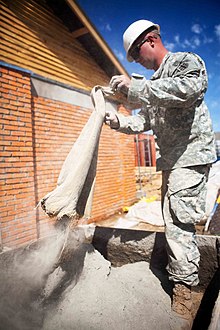
Back Sement Afrikaans Zement ALS ሲሚንቶ Amharic Cimento AN أسمنت Arabic Cementu AST Sement Azerbaijani Цемент Bashkir Zement BAR Cements BAT-SMG


A cement is a binder, a chemical substance used for construction that sets, hardens, and adheres to other materials to bind them together. Cement is seldom used on its own, but rather to bind sand and gravel (aggregate) together. Cement mixed with fine aggregate produces mortar for masonry, or with sand and gravel, produces concrete. Concrete is the most widely used material in existence and is behind only water as the planet's most-consumed resource.[2]
Cements used in construction are usually inorganic, often lime or calcium silicate based, which can be characterized as hydraulic or the less common non-hydraulic, depending on the ability of the cement to set in the presence of water (see hydraulic and non-hydraulic lime plaster).
Hydraulic cements (e.g., Portland cement) set and become adhesive through a chemical reaction between the dry ingredients and water. The chemical reaction results in mineral hydrates that are not very water-soluble. This allows setting in wet conditions or under water and further protects the hardened material from chemical attack. The chemical process for hydraulic cement was found by ancient Romans who used volcanic ash (pozzolana) with added lime (calcium oxide).
Non-hydraulic cement (less common) does not set in wet conditions or under water. Rather, it sets as it dries and reacts with carbon dioxide in the air. It is resistant to attack by chemicals after setting.
The word "cement" can be traced back to the Ancient Roman term opus caementicium, used to describe masonry resembling modern concrete that was made from crushed rock with burnt lime as binder. The volcanic ash and pulverized brick supplements that were added to the burnt lime, to obtain a hydraulic binder, were later referred to as cementum, cimentum, cäment, and cement. In modern times, organic polymers are sometimes used as cements in concrete.
World production of cement is about 4.4 billion tonnes per year (2021, estimation),[3][4] of which about half is made in China, followed by India and Vietnam.[3][5]
The cement production process is responsible for nearly 8% (2018) of global CO2 emissions,[4] which includes heating raw materials in a cement kiln by fuel combustion and resulting release of CO2 stored in the calcium carbonate (calcination process). Its hydrated products, such as concrete, gradually reabsorb substantial amounts of atmospheric CO2 (carbonation process) compensating near 30% of initial CO2 emissions, as estimations suggest.[6]
- ^ "Draeger: Guide for selection and use of filtering devices" (PDF). Draeger. 22 May 2020. Archived (PDF) from the original on 22 May 2020. Retrieved 22 May 2020.
- ^ Rodgers, Lucy (17 December 2018). "The massive CO2 emitter you may not know about". BBC News. Retrieved 17 December 2018.
- ^ a b "Cement" (PDF). United States Geological Survey (USGS). Retrieved 26 September 2023.
- ^ a b Cite error: The named reference
chathamhousewas invoked but never defined (see the help page). - ^ Cite error: The named reference
Hargreaveswas invoked but never defined (see the help page). - ^ Cao, Zhi; Myers, Rupert J.; Lupton, Richard C.; Duan, Huabo; Sacchi, Romain; Zhou, Nan; Reed Miller, T.; Cullen, Jonathan M.; Ge, Quansheng; Liu, Gang (29 July 2020). "The sponge effect and carbon emission mitigation potentials of the global cement cycle". Nature Communications. 11 (1): 3777. Bibcode:2020NatCo..11.3777C. doi:10.1038/s41467-020-17583-w. ISSN 2041-1723. PMC 7392754. PMID 32728073.
© MMXXIII Rich X Search. We shall prevail. All rights reserved. Rich X Search